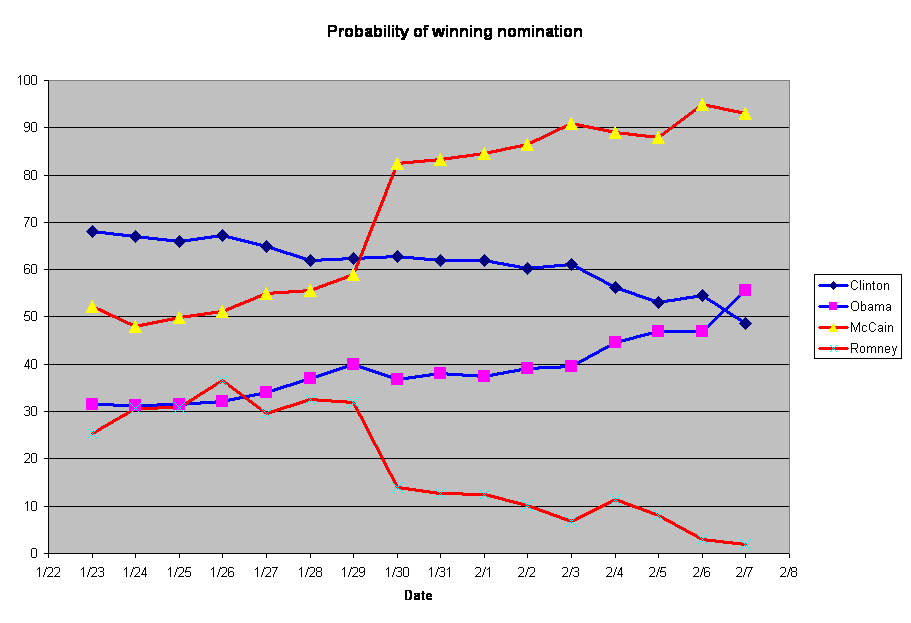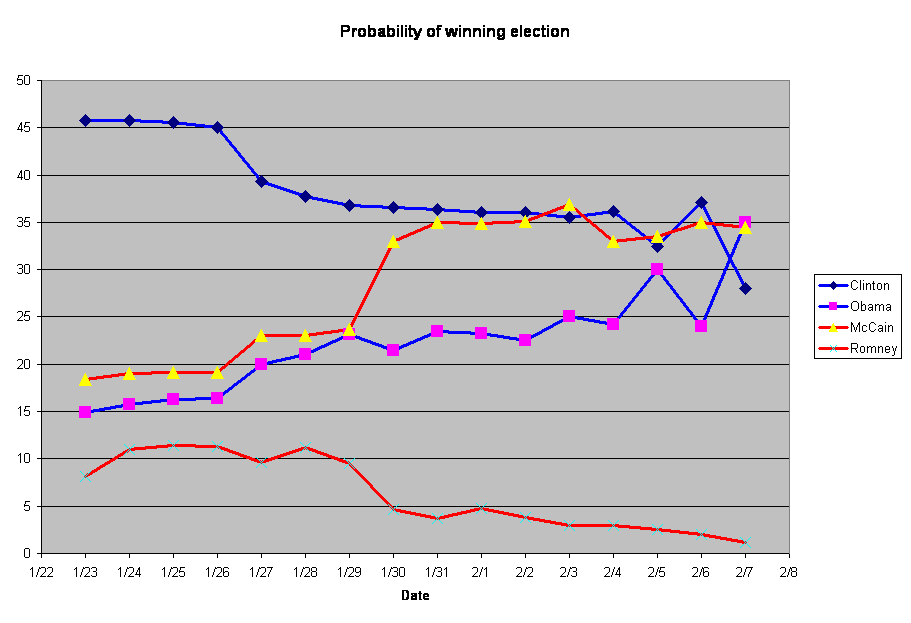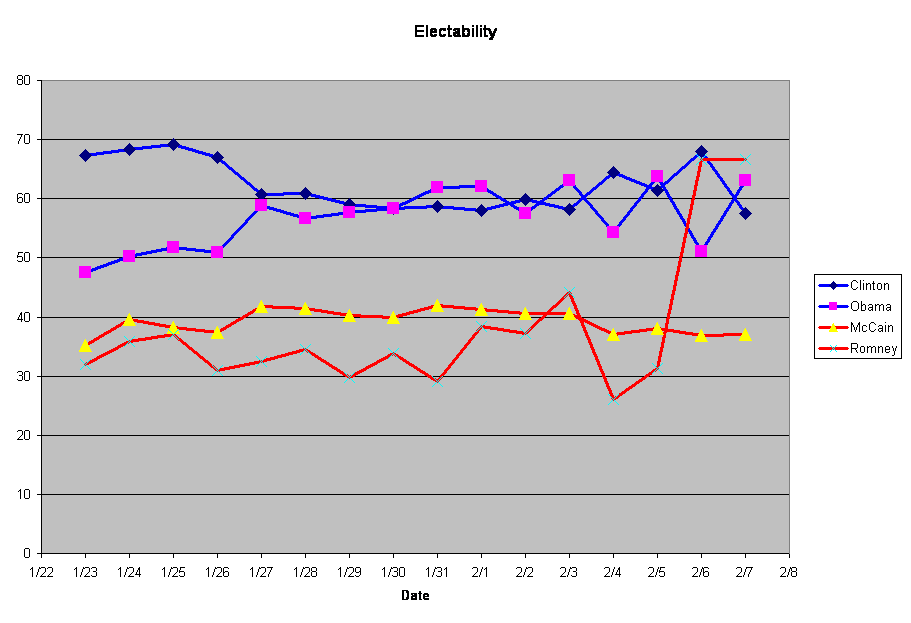I got the phone call today telling me that I officially have tenure. Now I can make like a sea squirt.
Author: Ted Bunn
Five years of WMAP
Update: The New York Times has a short piece about the data release. Like me, they emphasize the increased precision of estimates of cosmological parameters such as the age of the Universe, and don’t cite any surprises in the data.
The WMAP five-year data have been released. The WMAP maps of the microwave background radiation are one of the most important sets of data in cosmology. A lot of what we know about dark matter, dark energy, the expansion rate of the Universe, inflation, and things like that come from this data set. In a quick glance at the abstracts of the papers and at the tables of parameters, I don’t see any big surprises: the error bars on parameters have gotten smaller, but nothing has radically changed. That’s pretty much what one would expect, of course.
It’ll take a while to chew through all of the results, so maybe there are big surprises that I didn’t notice.
The smallness of the errors on a lot of the parameters are amazing. To take just one example, the Hubble constant (that is, the expansion rate of the Universe) is 72 +/- 3 km/(s Mpc) according to this data. Cosmologists have been trying to measure this number for nearly a century, and as recently as the 1990s, it was uncertain by nearly a factor of 2. Now we know it (and a bunch of other things) with uncertainties of only a few percent.
Here’s the temperature power spectrum from the new data, along with some other experiments. (All plots in this post are from this paper.)
It continues to amaze me how well the data match theoretical predictions.
The next frontier in the microwave background is measurements of the polarization, which is a much harder prospect. The easiest thing to measure about polarization is its cross-correlation with temperature, and WMAP has nailed that very well:
But the community is hoping to do better than that. The next challenge is to measure the polarization directly, without cross-correlating with the temperature. WMAP and other experiments have done that, but still with very large error bars:
But even that’s not the whole story. This data shows the E component of the polarization, but there’s another polarization signal called the B component, which is an order of magnitude or more smaller. That component is predicted to contain information about inflation that’s hard to get any other way, so a bunch of people are trying to figure out whether it can be measured. The MBI experiment I’m working on is a technology pathfinder for this effort. Looking at how hard WMAP had to work to get any information at all about the larger E signal, you can see that we have our work cut out for us!
Anybody out there?
Since hardly anybody knows I have a blog, I assume that hardly anyone’s reading this. If you’re reading this, and I don’t know it, post a comment to let me know you’re out there. I’ll be much more motivated to post things if I think anyone’s watching.
Also, in case you’re wondering, I really enjoy playing Dr. Science, so if you have any science questions you think I might be able to answer, drop me an e-mail. I’ll answer here on the blog if I can. My main areas of expertise are big-bang cosmology and relativity, but you can try me on other topics in astrophysics and physics too.
The End of Cosmology?
According to Scientific American, it’s coming. The fact that the Universe’s expansion is accelerating means that we gradually have less and less access to information about the Big Bang. This is true in principle, but it’ll take billions of years before there’s a significant loss of information.
I guess we should increase cosmology funding now: We need to find out all we can before the information goes away!
Mercury
I’ve enjoyed seeing the pictures of Mercury from the MESSENGER flyby. (If you haven’t already seen it, you should definitely check out pictures of the spider.) So far, the news accounts don’t seem to do a very good job explaining the scientific importance of the results. Here’s an article that gives quite a bit more detail about the sorts of questions that can be addressed with these data.
At this stage, not surprisingly, the data have raised a lot more questions than they’ve answered. It’ll be a lot of fun to see what comes out of the rest of the mission.
By the way, here’s a nice introductory physics puzzle: Why is it hard to get to Mercury? Obviously, it takes a lot of energy to get to the outer planets, since you have to go “uphill” against the Sun’s gravity. But Mercury’s dowhill from us, so it ought to be easy to get there.
More on electability
There seems to be more and more talk about which Presidential candidate is most “electable,” at least on the Democratic side. As I noted in an earlier post, the political futures market gives a way to assess electability. Here are some graphs showing what the market has thought about the electabilities of the two leading candidates in each party over the past few weeks.
First, the probabilities of winning the party nomination:
(Click on the images to get better-looking versions.)
Next the probabilities of winning the Presidency:
The ratio of these two is the electability (probability of a candidate’s winning the election given that he or she gets the nomination):
By the way, I think that the big jump in Romney’s electability in the last couple of days is probably just a fluctuation. The other big features you can see here are South Carolina on the Democratic side, Florida on the Republican side, and the current uncertainty in interpreting Super Tuesday on the Democratic side. Perhaps the most important thing, from the point of view of voters concerned about electability, is that Clinton and Obama are consistently very close to each other.
In the end, what you make of these results is up to you. Some people seem to attribute to the futures markets an almost magical “wisdom-of-crowds-style” ability to discern the Truth. It’s certainly possible to exaggerate that sort of thing, but at the very least what we’re looking at here is the average view of a community of people who pay a lot of attention to this subject and who are willing to put money behind their beliefs. If the numbers here strongly disagree with what you think about the candidates’ electabilities, then I have two questions for you:
1. Are you confident that you know more than this group of people?
2. If so, why don’t you bet on it?
After all, if you think that the probabilities shown here are wrong, then you can place bets on the futures markets (specifically, Intrade, which is where the above data comes from) where the odds are weighted in your favor.
Why doesn’t the Sun have an iron core?
The Q+A column in today’s New York Times is uncharacteristically weak. The question was “Why doesn't [the Sun] have a core of heavier elements that sank to the center?” The main problem with the column is that it doesn’t really answer the question. Here’s what I’d say.
Although the Sun is made mostly of hydrogen and helium, it does have trace amounts of heavy elements. These do not settle to the core but are distributed throughout the volume of the Sun. The reason is temperature: there is enough thermal energy in the solar interior to keep the heavy elements bouncing around. As an analogy, consider the Earth's atmosphere. Although carbon dioxide molecules are heavier than nitrogen molecules, there's plenty of thermal energy to keep the CO2 from settling at the bottom of the atmosphere.
The article also presents the impression that the Sun will produce its own heavy elements later in its life. The Sun will produce only helium, carbon, and oxygen. Elements heavier than oxygen are produced only in more massive stars.
I sent the Times a letter to this effect, but I don’t know if they’ll care.
Update: They didn’t.
Electability
I’m not going to write about politics in this blog — there’s plenty of that out there already. And I’m certainly not going to engage in any sort of political advocacy. But I thought of an interesting application of probability theory to the upcoming election, and I thought I’d summarize it here.
Remember back in 2004, when it seemed like every Democratic voter was basing his or her choice on which candidate was most “electable”? People’s gut feelings about this sort of thing are generally pretty unreliable, so it’s kind of interesting to look for a data-based answer to the electability question. It occurred to me recently that the various political futures markets provide a good way to answer that question for the upcoming election.
For those who don’t know about the political futures markets, they’re basically a way that people can bet on various political events, including the upcoming US Presidential race. Slate has a good description with lots of nice graphs. The odds on all of these bets can be interpreted as giving the probabilities of various outcomes in the race, as estimated by the community of bettors. These probabilities give enough raw data to measure each candidate’s “electability.”
By electability I mean the probability that a candidate will win in the general election, given that he (or she) gets the nomination. One of the futures markets (Intrade) lets people bet on both who will get the nomination and who will win the general election. The ratio of these for any given candidate is the electability. It’s just Bayes’s Theorem:
P(Hillary wins the presidency) =
P(Hillary gets the nomination) * P(Hillary wins the presidency | Hillary wins the nomination).
[In case it’s not familiar notation, P(y | x) means the probability that y occurs given that x occurs.]
The last factor on the right is Hillary’s electability. The futures market tells us the other two probabilities for each candidate. So we can find the electabilities of all the candidates by simple division. Before looking below, take a guess about which leading candidates in the two parties are most electable.
What my lab group is up to these days
Here are the main things our group has been working on these days, with links to papers and posters.
Some good web sites
Ned Wright’s Cosmology Tutorial: A great resource for all sorts of cosmology news and information.
Frequently Asked Questions about Black Holes (shameless self-promotion!)
John Baez’s web site, which is full of information about a lot of different topics in mathematical physics. The parts I’m most interested in are the ones about general relativity and gravity (and not just because I co-wrote some of it.)
For technical articles about astrophysics and cosmology, the place to go is the astro-ph arXiv.
For great astronomy pictures, you can’t beat NASA’s Astronomy Picture of the Day.
Update: These are now listed on the blogroll (over on the right), which is where they belong.


